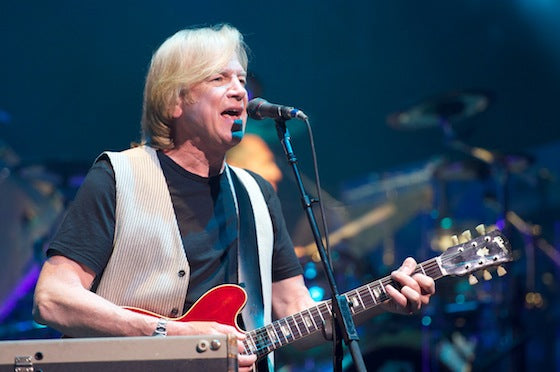 When an artist is indelibly identified primarily with an incredibly successful rock band and well-known for writing and singing dozens of its signature songs, any attempt to launch a solo career is bound to be a challenge. And when the individual in question is Justin Hayward, one of the longtime mainstays of the Moody Blues, any effort of the sort becomes all the more daunting.
When an artist is indelibly identified primarily with an incredibly successful rock band and well-known for writing and singing dozens of its signature songs, any attempt to launch a solo career is bound to be a challenge. And when the individual in question is Justin Hayward, one of the longtime mainstays of the Moody Blues, any effort of the sort becomes all the more daunting.
Hayward joined the Moodys immediately after its transition from a wannabe blues band with the minor chart hit, "Go Now," and helped transform them into bold forebears helming the prog rock revolution of the late '60s and early '70s. It was Hayward who penned such FM standbys as "Nights in White Satin," "Tuesday Afternoon," and "Your Wildest Dreams."
Even now, with six solo studio albums and a prominent role on the best-selling concept album The War of the Worlds to his credit, he's still readily identified with the songs he contributed to the band's classic canon. Nevertheless, Spirits of the Western Sky, Hayward's first solo outing since 1996's The View From the Hill, went a long way toward elevating his solo profile.
With the Moodys seemingly at a standstill as far as any new recordings were concerned, Hayward found ample reason to tour with the band and also venture out on his own. Hayward's new album/DVD, Spirits... Live -- Live From the Buckhead Theater, Atlanta, provides a telling preview of the solo show he'll offer when his current tour lands at the Parker Playhouse on Friday.
With its generous sampling of Moody Blues classics and various highlights from his solo catalog, expect an intriguing overview of Hayward's career spanning more than 40 years of essential tunes.
New TimesWhen you're faced with the challenge of doing the Moody Blues material in a solo context, does it take a lot of rearranging and rethinking?
Justin Hayward: Not really, because what I did was just to go back to the way the songs were in my music room, exactly the way I took them to the band, or I took them into the music studio, or in the last few years, to the engineer or the producer. That's the basics of it, and I've tried to include the things I would have recorded at home on my own gear and brought into the studio.
What's missing of course is the drums, but not having the drums allowed the acoustic guitars to breathe, and you can hear all the different pitching and intonation, which is lovely actually. So I'm bringing my music room vibe out on the road. That's how it is.
You do have some fine musicians backing you up, but of course the Moodies harmonies aren't there and the focus is on your voice almost entirely. Was there any special thinking as to how to work around the missed voices heard on the albums?
I'm lucky that I get to have that with the Moodys in that big production. Thankfully, the Moodys are alive and well and this is certainly the best incarnation of the Moodys that I've been in. That's for sure. Julie Ragins, who tours in my solo band, has been handling those harmony vocals for quite some time now with the Moodys, so she knows them well.
It wouldn't be right to bring in all these other voices just for that. In truth, on the records, I would always do the harmonies myself. So it was just a question of being a little more selective with the harmonies that we use. One really allows me to be really comfortable with the other. This small show with my acoustic guitars -- my guitars from home -- really frees my mind to do the Moodys thing as well. It's a perfect complement. Without either one of them, I'd be thinking what else I could do to get my own pleasure out of touring and to rediscover the songs for myself.
How are you able to narrow down the selection you include from such a vast amount of material both in the group and your solo catalog?
Well, I've said it before. It's not what we play, it's what we leave out.
You have said that before. The last time we spoke in fact.
Yes, and I say it again. It's about finding things that work and things that seem to be appropriate in the moment that you do them. I'm recording the show I'm doing tonight, and the producer is asking me, "Well, have you got anything else?"
So I thought about it last night and decided I'll do some unusual things and just see how they work. I think about things that are well-suited for acoustic guitar. It's harder to do things I wrote on keyboards. On this tour, I tried some things I wrote on keyboards, but I feel much more comfortable singing when I have a guitar in front of me. The songs on this tour are coming out of those acoustic guitars and what's right for this set.
When you're on stage with the Moodys, you have John, you have Graeme, you have the other members of the band. But when you're up there solo, most of the focus is on you. Is that intimidating in any way?
I know what you mean, but on the other hand, it's only me to blame. I can't blame anyone else if something goes wrong or somebody doesn't come up to par. It's a fact that I want to do right by the songs. It's about the songs; it's not so much about me. It's about what's being said in the songs and how that comes across. And for me, there is a kind of cathartic element. The Moody Blues show is a big production and there's a lot that goes into that. Not just the songs or the playing; it's the whole presentation of it and the way it looks and the way it's put across. All that kind of stuff.
But with the solo shows, it's really just about the songs and what comes out of those guitars. So I'm trying to do justice to those and express those, and in doing that, it's kind of a cathartic thing for me. There are things in the past that I didn't really understand at the time, even when they had to do with my own life. I'm well aware that it's not that important -- music is ultimately trivial -- so I don't expect anyone to get worked up about my own catharsis, but still, it's in there.
I assume that a lot of the people that come to the show will know these songs already, but hopefully they'll enjoy hearing them the way they were originally conceived.
Do you find that the audiences have certain expectations. Do you get a certain vibe from them that dictates what you present and how you present it?
I do, and I kind of think there's a point in the show where they're waiting, and it's like, "OK, come on, do it!"
Funny enough, the one that breaks that ice is "Forever Autumn." It's a song I never got to do with the Moodys. That's the most peculiar thing. It's the song that kind of opens the floodgates in the show, and it's a release.
Is this the longest you've toured behind one of your solo albums?
It is, because I'm really building something that I hope can last. I really see a great opportunity here. The promoters are very welcoming to me. They want me to tour. I just don't feel like saying no. This year, I would have done five tours. It's a real busy year for me. Next year looks like it will be real busy too... Not so much with solo things, but we have a lot of Moody Blues activity set up for Europe and the U.K. It's rather intense, but I figure I've gotten to the time in my life where I want to do this.
When you're in your 20s and 30s and 40s, you figure you can take your time, but now I really want to do it while it's there for me. While the promoters are there, while the crowds are there.
Is it difficult trying to arrange the solo tours in the midst of the Moody Blues activities?
Sometimes. The Moodys kind of take priority, but there was one time this year when I said to the guys, "Listen, I've been offered some nice stuff and I'd really like to do it in this time period and so I won't be available to the band," and they were just fine with it.
So they're fine with you taking off and doing your solo thing?
It's not something that's discussed so much. I know there's always a general feeling in the band that whatever I do, or whatever somebody else does is, that there's always going to be an element of the Moodys in it regardless.
So the other guys don't feel left out in the cold so to speak?
I couldn't see a new album of Moodys material on the horizon. There are a lot of other things for the Moodys to do, but I had so many songs and I just had to do them. And Eagle Rock, the record company, had been so supportive, so behind me. It's like Decca in the old days where you have a record company that says, "Whatever you want to do is just fine with us. We're right behind you. We'll give you a promotion team, we're going to produce it well."
And that's why I really started touring, in support of them, to give them back some of the stuff they'd given me. They invested a lot of faith in me and that's wonderful to have a record company like that. And then I got sort of hooked on this whole idea of solo touring. And when I found my guitarist, Mike Dawes, the whole thing just fell into place. He's worth the price of admission all on his own.
How did you find him?
It was one of those things. You know how when you're online, you look to one thing on YouTube and it leads to another? I clicked on a link I found to Mike, and I immediately thought, "This kid's brilliant!" He's part of this whole new generation of players. He has this unique way of playing. I just called him up and we met and it just clicked really. He loves the songs and he learns them instantly. It's such a great pleasure for me. And he's such a road buddy and that's so important to me.
One can only imagine how delighted he must have been to get a call from Justin Hayward.
I think so, and I hope so. His dad was (laughs). His dad was really turned on, because Mike's only like 24-years-old. (laughs). He really went for it. And I thought, I have to give him his own thing, so he opens the show for me. You won't see anyone play like he does.
Many of the solo songs you're playing on your Spirits album seem like they could fit so well into the Moodys repertoire. Is there still no plan for the band to go into the studio again at this point?
(Takes deep breath) I don't know what it is. We're in this state where we're enjoying rediscovering our old catalogue. We're discovering ourselves in a kind of road format. I think we're just happy enjoying that. And so we're being a bit selfish. We're doing the things we find enjoyable. We're scattered all around the world. One or two of us would have to leave home for a couple of months just to record. Albums are made differently now. Each guy records his own, but sort of separately. So I don't know what it would be like anymore. I think we're just happy doing what we're doing now.
You personally seem very happy to be making new music. Your last studio album was certainly highly anticipated after an eight year lapse from your last individual outing. And the response was very positive, so that indicates there is a hunger for new music, either solo or together.
I hope so. However, we're also stuck with that dilemma that if we do something new, the label will want to piggyback another greatest hits on top of it. They're interested in the catalog as well, and recycling the old material. That's not a reason not to do it, but I'm not sure how it would happen, that's all.
As far as you're own efforts however, can we safely assume there will be another Justin album on the horizon?
I hope so. I have some material left over from the last album, so I think so.
In listening to your music, it becomes so apparent that you have a certain serenity that seems to define you through the music. The emotional connection you establish is so apparent in your songs. So are you, for lack of a better word, a metaphysical sort of guy?
I take that as it's meant, as a compliment. But it's also a little bit disturbing. I wonder what the hell my life would be like without the music. It would be unfulfilled somehow. There would be something missing. So that means I have to have a lot of patient people around me who accept the fact that, "Yes, he's that guy who reads his books all the time and plays his guitar," and they're not allowed into that world.
Well, sadly, you and I have never had the opportunity to go out drinking or anything like that, so I can't really attest to the wackier side of Justin Hayward.
(Laughs) I suppose not.
Justin Hayward of the Moody Blues performs at 8 p.m. on Friday, October 24, at Parker Playhouse, 707 NE Eighth St., Fort Lauderdale. Tickets cost $37.50 to $57.50 plus fees. Call 954-764-1441, or visit parkerplayhouse.com.
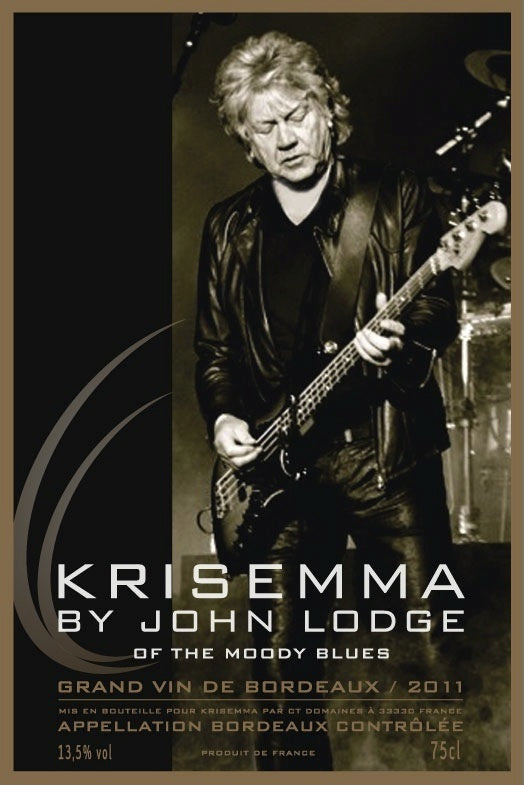 Krisemma Wine is available in the UK for the next two weeks via JohnLodge.com and will then be available again in February.
To tie in with the UK release, John recently did a Q & A about his Krisemma 2011 Bordeaux AOC Wine, check it out at http://johnlodge.com/?p=439. Signed bottles of the wine are available in the UK for the next two weeks, see http://johnlodge.com/?p=425 for more details on the wine and how to order!
Information on US availability will be with you in the new year!
Krisemma Wine is available in the UK for the next two weeks via JohnLodge.com and will then be available again in February.
To tie in with the UK release, John recently did a Q & A about his Krisemma 2011 Bordeaux AOC Wine, check it out at http://johnlodge.com/?p=439. Signed bottles of the wine are available in the UK for the next two weeks, see http://johnlodge.com/?p=425 for more details on the wine and how to order!
Information on US availability will be with you in the new year!
 The intimate atmosphere of Chicago’s City Winery proved the perfect venue for Moody Blues guitarist and songwriter Justin Hayward to make musical magic.
Hayward performed to full houses during three shows Monday and Tuesday at the supper-club like theater. During the 10 p.m. Monday show, Hayward was in stellar form as he offered a blend of favorites and contemporary material.
“We’re going to be doing some new things and some old things in this show,” he told the crowd. The solo concert largely put the focus on tunes from his latest solo album, released last year, “Spirits of the Western Sky.”
The current tour also celebrates the release of “Spirits …Live – Live at the Buckhead Theatre,” which was released in August on DVD, Blu-ray, CD and digital formats. The album was recorded while he was on a solo tour in 2013 to support “Spirits of the Western Sky.”
During the concert, Hayward was a personable songsmith as he not only delivered passionate renditions of beloved tunes and newer selections but also gave a bit of insight into what inspired the songs.
On the show playlist were “One Day, Someday,” Moody Blues’ hit “Tuesday Morning,” which he opened with, the upbeat “Your Wildest Dream,” “The Eastern Sun” and the poignant “The Western Sky,” which Hayward described as being inspired by growing up in Swindon, England.
“My late brother and I shared a room at the back of the house,” he said, adding from the window in that room they saw whatever “weather was coming,” beautiful sunsets and more from “that Western Sky.”
Prior to the closing number “I Know You’re Out There Somewhere,” Hayward treated fans to a strong version of the iconic “Nights in White Satin,” the musical masterpiece he penned.
The intimate atmosphere of Chicago’s City Winery proved the perfect venue for Moody Blues guitarist and songwriter Justin Hayward to make musical magic.
Hayward performed to full houses during three shows Monday and Tuesday at the supper-club like theater. During the 10 p.m. Monday show, Hayward was in stellar form as he offered a blend of favorites and contemporary material.
“We’re going to be doing some new things and some old things in this show,” he told the crowd. The solo concert largely put the focus on tunes from his latest solo album, released last year, “Spirits of the Western Sky.”
The current tour also celebrates the release of “Spirits …Live – Live at the Buckhead Theatre,” which was released in August on DVD, Blu-ray, CD and digital formats. The album was recorded while he was on a solo tour in 2013 to support “Spirits of the Western Sky.”
During the concert, Hayward was a personable songsmith as he not only delivered passionate renditions of beloved tunes and newer selections but also gave a bit of insight into what inspired the songs.
On the show playlist were “One Day, Someday,” Moody Blues’ hit “Tuesday Morning,” which he opened with, the upbeat “Your Wildest Dream,” “The Eastern Sun” and the poignant “The Western Sky,” which Hayward described as being inspired by growing up in Swindon, England.
“My late brother and I shared a room at the back of the house,” he said, adding from the window in that room they saw whatever “weather was coming,” beautiful sunsets and more from “that Western Sky.”
Prior to the closing number “I Know You’re Out There Somewhere,” Hayward treated fans to a strong version of the iconic “Nights in White Satin,” the musical masterpiece he penned. The singer-guitarist will perform band hits, solo work at Parker Playhouse.
By Nick Sortal,
The singer-guitarist will perform band hits, solo work at Parker Playhouse.
By Nick Sortal, 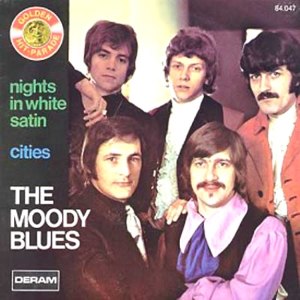 “It’s a song that never seems to go away," says The Moody Blues' Justin Hayward of the band's pop/proto-prog orchestral masterpiece and perennial hit Nights In White Satin. "It was a slow build, and of course, it was released a few times, but once it took hold, it did so in a really big way. It seemed to get into people’s minds and just stay there. The whole thing's very strange and wonderful."
The lush, transporting and immersive track, which appeared as a full-blown epic (clocking in at over seven and a half minutes, complete with a spoken-word poetry section called Late Lament) on the band's 1967 album Days Of Future Passed, was released in edited form as a single in November of that year. The song reached the top of the charts in France, but in the UK it only got as high as number 17.
“It was fantastic to hit the top in France, but of course, we were hoping to repeat that success elsewhere," Hayward says. "Once it dropped off the UK chart, that seemed to be it for the song." He laughs, then adds, "For a while, at least. As we all know, it came back bigger than ever, and it's had all of these different lives over the years."
In the following interview, Hayward recounts the writing and recording of The Moody Blues' signature song, as well as its unexpected re-entry into the charts in 1972, an occurrence that the singer says "changed my life and the band's lives forever."
Walk me through the writing of the song. As I understand it, you started it when you were 19.
“Right. It was in early 1967, and I’d just come home from a gig. I was living in a one-room flat. I sat on the side of the bed and wrote the basic two verses and two choruses with a 12-string acoustic. I took it to the rehearsal room the next day because the guys were expecting me to have something to work up for a stage show. I played it for them and they were like, ‘Huh… it’s OK.’ I don’t think they were that thrilled – they didn’t hear it straightaway.
“But then
“It’s a song that never seems to go away," says The Moody Blues' Justin Hayward of the band's pop/proto-prog orchestral masterpiece and perennial hit Nights In White Satin. "It was a slow build, and of course, it was released a few times, but once it took hold, it did so in a really big way. It seemed to get into people’s minds and just stay there. The whole thing's very strange and wonderful."
The lush, transporting and immersive track, which appeared as a full-blown epic (clocking in at over seven and a half minutes, complete with a spoken-word poetry section called Late Lament) on the band's 1967 album Days Of Future Passed, was released in edited form as a single in November of that year. The song reached the top of the charts in France, but in the UK it only got as high as number 17.
“It was fantastic to hit the top in France, but of course, we were hoping to repeat that success elsewhere," Hayward says. "Once it dropped off the UK chart, that seemed to be it for the song." He laughs, then adds, "For a while, at least. As we all know, it came back bigger than ever, and it's had all of these different lives over the years."
In the following interview, Hayward recounts the writing and recording of The Moody Blues' signature song, as well as its unexpected re-entry into the charts in 1972, an occurrence that the singer says "changed my life and the band's lives forever."
Walk me through the writing of the song. As I understand it, you started it when you were 19.
“Right. It was in early 1967, and I’d just come home from a gig. I was living in a one-room flat. I sat on the side of the bed and wrote the basic two verses and two choruses with a 12-string acoustic. I took it to the rehearsal room the next day because the guys were expecting me to have something to work up for a stage show. I played it for them and they were like, ‘Huh… it’s OK.’ I don’t think they were that thrilled – they didn’t hear it straightaway.
“But then  When an artist is indelibly identified primarily with an incredibly successful rock band and well-known for writing and singing dozens of its signature songs, any attempt to launch a solo career is bound to be a challenge. And when the individual in question is Justin Hayward, one of the longtime mainstays of the Moody Blues, any effort of the sort becomes all the more daunting.
When an artist is indelibly identified primarily with an incredibly successful rock band and well-known for writing and singing dozens of its signature songs, any attempt to launch a solo career is bound to be a challenge. And when the individual in question is Justin Hayward, one of the longtime mainstays of the Moody Blues, any effort of the sort becomes all the more daunting. It's been just over a month since The Moody Blues wrapped up their latest North American tour, but now frontman Justin Hayward is set to embark on a new U.S. solo trek . The monthlong outing kicks off Friday in Durham, North Carolina, and is plotted out through a November 17 concert in Chicago.
This tour leg is the third that the 68-year-old singer/guitarist has mounted without his band since the early-2013 release of his latest solo album, Spirits in the Western Sky , and he tells ABC News Radio that he's sort of getting addicted to playing these stripped-down shows.
"It's become a kind of drug for me," says Hayward. "I'm enjoying it, and it's the perfect balance to The Moody Blues."
Justin, who has been alternating solo tours and Moody Blues treks since the summer of 2013, notes that he's "very pleased that one allows the other."
He adds, "You know, the Moodies, the big production...if I just did that I'm not sure I'd be satisfied anymore. So, to have this, to bring my own acoustic guitars out and to enjoy them and to just play the role of
It's been just over a month since The Moody Blues wrapped up their latest North American tour, but now frontman Justin Hayward is set to embark on a new U.S. solo trek . The monthlong outing kicks off Friday in Durham, North Carolina, and is plotted out through a November 17 concert in Chicago.
This tour leg is the third that the 68-year-old singer/guitarist has mounted without his band since the early-2013 release of his latest solo album, Spirits in the Western Sky , and he tells ABC News Radio that he's sort of getting addicted to playing these stripped-down shows.
"It's become a kind of drug for me," says Hayward. "I'm enjoying it, and it's the perfect balance to The Moody Blues."
Justin, who has been alternating solo tours and Moody Blues treks since the summer of 2013, notes that he's "very pleased that one allows the other."
He adds, "You know, the Moodies, the big production...if I just did that I'm not sure I'd be satisfied anymore. So, to have this, to bring my own acoustic guitars out and to enjoy them and to just play the role of 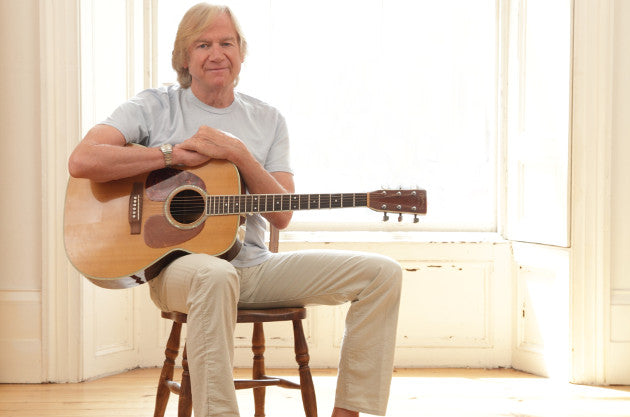 Music legends don’t come along every day, so I am always thrilled when one decides to take a moment to share his or her journey with me. But when
Music legends don’t come along every day, so I am always thrilled when one decides to take a moment to share his or her journey with me. But when 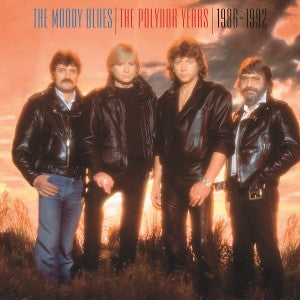 The Moody Blues - The Polydor Years
The Moody Blues - The Polydor Years Justin Hayward
Justin Hayward
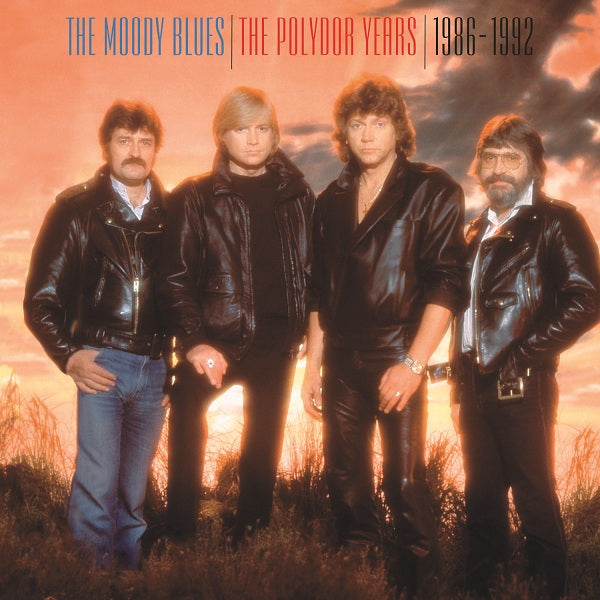 Due for release on November 24, the superbly packaged eight disc (six CDs and two DVDs) set brings together, for the first time, remastered editions of all The Moody Blues’ Polydor era albums, spanning the period 1986-1992. The package -
Due for release on November 24, the superbly packaged eight disc (six CDs and two DVDs) set brings together, for the first time, remastered editions of all The Moody Blues’ Polydor era albums, spanning the period 1986-1992. The package - 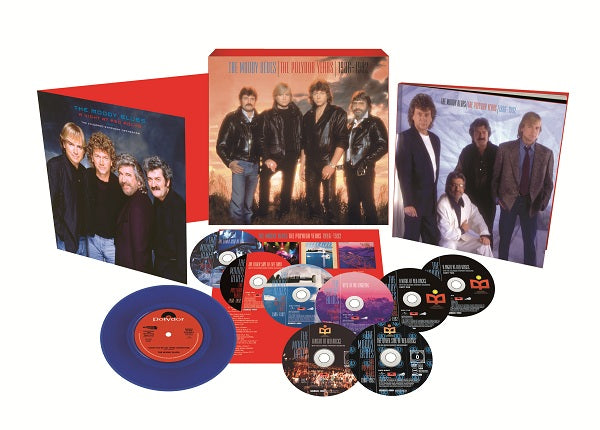 Pre-Order Your Copy Today from the Official Moody Blues Online Store.
Pre-Order Your Copy Today from the Official Moody Blues Online Store.
 Live Nation is delighted to announce the ‘Timeless Flight 2015’ Tour from The Moody Blues, one of the most enduring, creative and consistent groups in the world. Tickets go on sale on 19 September 2014 from
Live Nation is delighted to announce the ‘Timeless Flight 2015’ Tour from The Moody Blues, one of the most enduring, creative and consistent groups in the world. Tickets go on sale on 19 September 2014 from  Justin Hayward stood at center stage, dressed entirely in white, holding his guitar, and then he began strumming the familiar chords. In seconds, the crowd of 3,700 began to cheer, then sway and sing along.
The song, of course, was “Nights in White Satin,” the peak of The Moody Blues' two-set, 100-minute show on a beautiful Monday night at Pinewood Bowl.
Hayward, who was in strong voice, delivered it well, as did the band, composed of original Moodies John Lodge on bass and Graeme Edge on drums, along with a pair of keyboards, a backing singer/flautist and an extra drummer.
It was preceded by “I’m Just a Singer (In a Rock and Roll Band),” which, along with “Higher and Higher,” featured Edge coming out from behind the drums to perform. These were the rockingest songs of the night.
The second set opened with “Your Wildest Dream,” which built from flute and acoustic guitar to swelling keyboard and drums, and dropped again -- the “classical” element of the Moodies. Then, a couple songs later, came “Tuesday Afternoon,” one of the band’s defining songs that carry a late '60s vibe.
The Moodies embraced that vibe with a few onstage comments about '60s music festivals, hippies, etc., but more so with images projected on the video board behind them of old show posters, vintage performances, album covers, etc.
The first set, as Hayward had indicated in an interview, was primarily made up of the Moodies' more recent material, like “Say It With Love,” a 1991 song that was given a gorgeous reading. It was followed by “Peak Hour,” a lesser-known psychedelic gem from the band’s 1967 breakthrough album “Days of Future Passed.”
Monday night’s show, in all likelihood, was the year’s final Pinewood Bowl concert. It was another good show in a solid summer’s worth of events in the amphitheater that has become one of the top outdoor concert venues around.
Justin Hayward stood at center stage, dressed entirely in white, holding his guitar, and then he began strumming the familiar chords. In seconds, the crowd of 3,700 began to cheer, then sway and sing along.
The song, of course, was “Nights in White Satin,” the peak of The Moody Blues' two-set, 100-minute show on a beautiful Monday night at Pinewood Bowl.
Hayward, who was in strong voice, delivered it well, as did the band, composed of original Moodies John Lodge on bass and Graeme Edge on drums, along with a pair of keyboards, a backing singer/flautist and an extra drummer.
It was preceded by “I’m Just a Singer (In a Rock and Roll Band),” which, along with “Higher and Higher,” featured Edge coming out from behind the drums to perform. These were the rockingest songs of the night.
The second set opened with “Your Wildest Dream,” which built from flute and acoustic guitar to swelling keyboard and drums, and dropped again -- the “classical” element of the Moodies. Then, a couple songs later, came “Tuesday Afternoon,” one of the band’s defining songs that carry a late '60s vibe.
The Moodies embraced that vibe with a few onstage comments about '60s music festivals, hippies, etc., but more so with images projected on the video board behind them of old show posters, vintage performances, album covers, etc.
The first set, as Hayward had indicated in an interview, was primarily made up of the Moodies' more recent material, like “Say It With Love,” a 1991 song that was given a gorgeous reading. It was followed by “Peak Hour,” a lesser-known psychedelic gem from the band’s 1967 breakthrough album “Days of Future Passed.”
Monday night’s show, in all likelihood, was the year’s final Pinewood Bowl concert. It was another good show in a solid summer’s worth of events in the amphitheater that has become one of the top outdoor concert venues around.
 Photo By Jim 'JT' Gilbert
Photo By Jim 'JT' Gilbert Cory Schwartz/Getty Images
Cory Schwartz/Getty Images